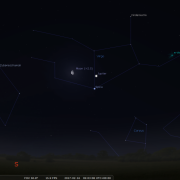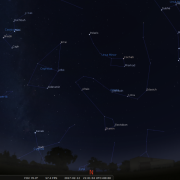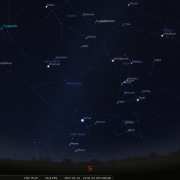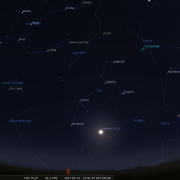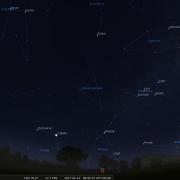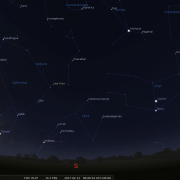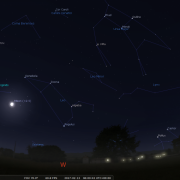In this month's Sky Notes:
Planetary Skylights

 Venus continues to dominate the evening sky – an unmistakeable beacon over in the SW. The crescent moon lies close to Venus on the first day of the month making for a pleasing visual treat, especially as Mars is also in the vicinity, indeed Venus and Mars are closest in the sky the following evening. Mars resembles an ochre star upper left of Venus.
Venus continues to dominate the evening sky – an unmistakeable beacon over in the SW. The crescent moon lies close to Venus on the first day of the month making for a pleasing visual treat, especially as Mars is also in the vicinity, indeed Venus and Mars are closest in the sky the following evening. Mars resembles an ochre star upper left of Venus.

 To counterbalance the two naked eye evening planets, two naked planets can also be found in the dawn sky. Conspicuous Jupiter is actually on view shortly before midnight at the start of the month and by 21:30h at the end, but for February the best observations of it would fall in the early morning hours. Look for it low in the east during the early part of late night, and towards the south for dawn.
To counterbalance the two naked eye evening planets, two naked planets can also be found in the dawn sky. Conspicuous Jupiter is actually on view shortly before midnight at the start of the month and by 21:30h at the end, but for February the best observations of it would fall in the early morning hours. Look for it low in the east during the early part of late night, and towards the south for dawn.
Telescopically, Jupiter always has something to offer, even for smaller apertures. Look for the banding on the disk and the attendant Galilean moons. Currently Jupiter lies above the bright star Spica in Virgo, view on the 15/16th when they are joined by a waning crescent Moon.
 Finally, Saturn is visible by 05:00h low to the SE. It resembles a prominent pearly star some distance to the left of ruddy hued Antares in Scorpius. Telescopically Saturn is a real joy to observe, with the rings well orientated. The crescent moon forms the apex of a triangle with Saturn and Antares on the 20th.
Finally, Saturn is visible by 05:00h low to the SE. It resembles a prominent pearly star some distance to the left of ruddy hued Antares in Scorpius. Telescopically Saturn is a real joy to observe, with the rings well orientated. The crescent moon forms the apex of a triangle with Saturn and Antares on the 20th.
Meteor Showers

There is just one minor meteor shower this month, the Alpha Aurigids.
The peak (if you can call it that) falls between Feb 6-9th. The Zenith Hourly Rate only reaches sporadic levels, barely half a dozen per hour, but if you do spot a meteor heading away from the direction of the zenith, (overhead) where the constellation of Auriga resides at this time of year, it is likely to be an Aurigid!
Comets
February could be a busy month with the possibility of a couple of periodic comets visible in binoculars.
Having spent the early part of January low in the SW in Capricornus Comet 45P is on the move making its closest approach to Earth on Feb 11th, coming within 7.7 million miles and brightening again to a predicted magnitude of +6. This is just on the edge of viewing with the naked eye. Look for it near the constellation Hercules just before dawn. See chart
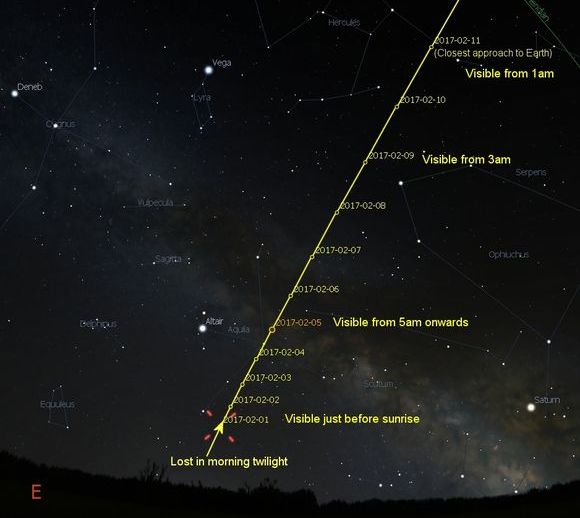
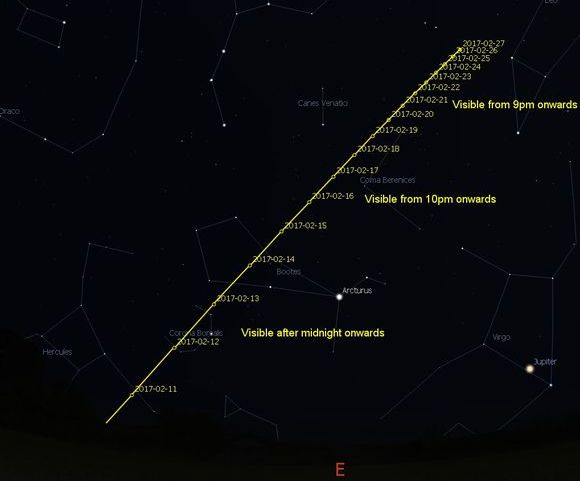
Finder Charts for Comet 45P Honda-Mrkos-Pajdusukova:
02-11-Feb-2017 (top) and 11-28-Feb-2017 (bottom)
The short periodic comet 2P Encke will once again returning. Discovered by Pierre Mechain in 1786, the comet has a period of 3.3 years and will be seen in the northern hemisphere this year, prior to perihelion in mid March. During February the comet brightens hopefully becoming a binocular object. It is though dropping rapidly into the northern dusk and will be lost by early March. The comet is the progenitor of the Taurid meteor shower.
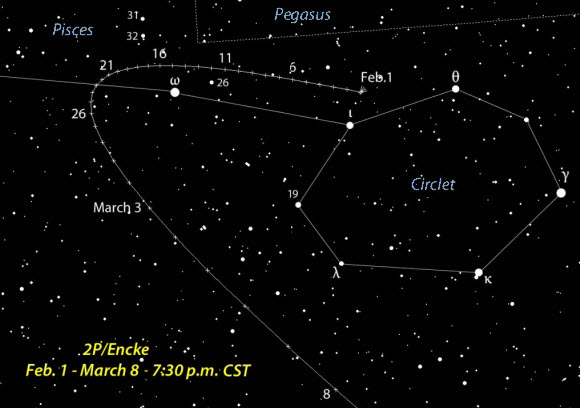
Finder Chart for Comet 2P Encke: 01-Feb-2017 to 08-Mar-2017
February 2017 Sky Charts
Click each image to see a full-size Sky Chart:
Additional Image Credits:
- Planets and Comets where not otherwise mentioned: NASA
- Sky Charts: Stellarium Software
- Log in to post comments


